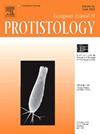Two new Raabena species and a new Pararaabena species (Ciliophora, Entodiniomorphida) with redescriptions of Raabena bella and Pararaabena dentata.
IF 1.9
2区 生物学
Q4 MICROBIOLOGY
引用次数: 0
Abstract
The genera Raabena and Pararaabena (Ciliophora, Entodiniomorphida, Blepharocorythidae) were monospecific, and their type species are Raabena bella Wolska, 1967 and Pararaabena dentata Wolska, 1968. They have been found in Asian elephants and closely resemble each other: ovoid and laterally compressed body; non-retractable adoral ciliary zone; funnel-shaped vestibulum; three non-retractable somatic ciliary arches. Furthermore, the positional relationship between the vestibular ciliary zone and the anterior dorsal ciliary zone identifies Raabena and Pararaabena: these two ciliary zones are connected in Raabena while they are separated in Pararaabena. While investigating entodiniomorphid ciliates of Asian elephants, the author often encountered ciliates similar to Raabena bella but with a sinuous body or with a small body and ciliates similar to Pararaabena dentata but with a slender body or with no or two caudal lobes. In this study, their general morphology and infraciliature were compared to R. bella and P. dentata to know whether they are new species or morphological variations in a species. As a result, the present study redescribed R. bella and P. dentata, and described R. sinuosa n. sp., R. bellafilia n. sp., P. gracilis n. sp., and morphotypes of P. dentata.二新种和一新种(纤毛虫目,内二形目),并重新描述了贝拉和齿形旁贝拉。
Raabena属和Pararaabena属(Ciliophora属、Entodinomorpida属、Blepharocorythidae属)为单种,其模式种为Raabena bella Wolska,1967年和Pararaabena dentata Wolska(1968年)。它们在亚洲象身上被发现,彼此非常相似:卵球形,侧面受压;不可伸缩的崇拜睫状区;漏斗状前庭;三个不可伸缩的体纤毛弓。此外,前庭纤毛区和前背纤毛区之间的位置关系确定了Raabena和Pararaabena:这两个纤毛区在Raabena连接,而在Pararaabeina分离。在研究亚洲象的内宿异形纤毛虫时,作者经常遇到类似于贝拉蛙但身体弯曲或体型较小的纤毛虫,以及类似于齿副蛙但身体细长或没有或两个尾叶的纤毛虫。在本研究中,将它们的一般形态和纤毛下结构与R.bella和P.dentata进行了比较,以了解它们是新种还是一个物种的形态变异。因此,本研究重新描述了R.bella和P.dentata,并描述了R.sinuosa n.sp.、R.bellafilia n.sp.和P.gracilis n.sp.以及P.dentata的形态类型。
本文章由计算机程序翻译,如有差异,请以英文原文为准。
求助全文
约1分钟内获得全文
求助全文
来源期刊

European journal of protistology
生物-微生物学
CiteScore
4.60
自引率
20.70%
发文量
55
审稿时长
14.6 weeks
期刊介绍:
Articles deal with protists, unicellular organisms encountered free-living in various habitats or as parasites or used in basic research or applications. The European Journal of Protistology covers topics such as the structure and systematics of protists, their development, ecology, molecular biology and physiology. Beside publishing original articles the journal offers a forum for announcing scientific meetings. Reviews of recently published books are included as well. With its diversity of topics, the European Journal of Protistology is an essential source of information for every active protistologist and for biologists of various fields.
 求助内容:
求助内容: 应助结果提醒方式:
应助结果提醒方式:


